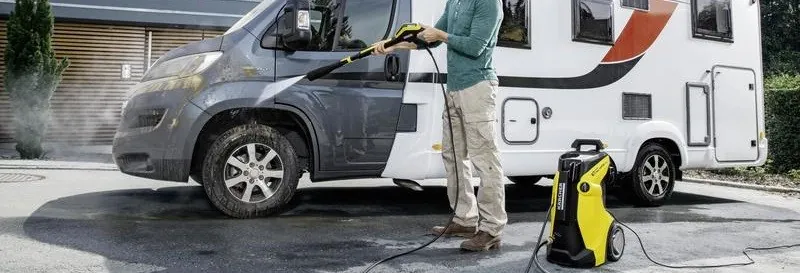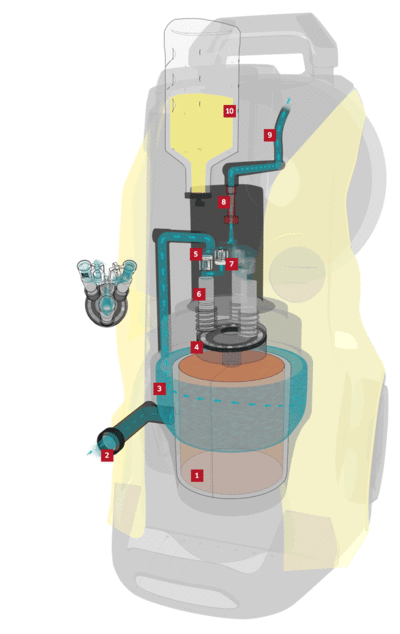Roll out the pressure washer! Many people now routinely use these super-powerful hoses (also known as "power washers") to blast things clean with water jets pressurized at about 100–200 times the pressure of the air around us (that's 1500–3000 pounds per square inch or psi). They're brilliant on patios, drives, lawn furniture, barbecue grills, and all kinds of other outside grime. Let's take a closer look at how they work!

Why pressure jets get things cleaner
That's when a pressure washer comes in really handy. It uses a narrow, high-pressure jet of hot or cold water to blast dirt free. Because the water is traveling fast, it hits the dirty surface with high kinetic energy, knocking dirt and dust away like a constant rain of tiny hammer blows. It's only water, though, so it doesn't damage most hard surfaces. Having said that, it's a good idea to test a pressure washer on an inconspicuous area before you start work to make sure it doesn't harm the surface you're cleaning. Always read the instructions before you use a pressure washer!
Пример: АВД «Керхер K 7 Full Control»

A pressure washer is less sophisticated than it sounds. It's really just a water pump powered by an electric motor. The washer takes in ordinary water from a faucet (that's a tap to you folks in the UK), the pump accelerates the water to high pressure, and then squirts it from a hose at speed through a trigger gun. You can fit various other attachments to the end of the hose for cleaning different things. These, then, are the main parts you'll find inside a pressure washer: Water inlet: A hose that connects the pressure washer to the main water supply. There's usually a filter in the inlet to stop dirt and debris entering the washer and clogging up the works. Little bits of grit are the last thing you want inside your washer—especially since they could come blasting out of the other end at high speed! Electric motor or gas engine: Most smaller, pressure washers (such as the very popular ones made by Kärcher) run off the domestic electricity supply, but bigger models are powered by compact gasoline engines. The engines are similar to the ones you'd find in lawnmowers (typically power rated at around 3–4kW or 3.5–5.5HP). Gas engine models are great if you're working outside in places where an electricity supply is hard to find (or where a long trailing cable would be dangerous or inconvenient). The motor or engine is designed to power the water pump. Filling up a gasoline-powered pressure washer Photo: Although domestic pressure washers are typically powered by electricity, bigger ones are often driven by small gasoline engines and produce considerably more powerful water jets. Here's the engine inside a typical gas-powered washer used by the US Marine Corps being refilled ready for cleaning helicopters. This one's made by Jenny and rated at a pressure of 3400 psi (roughly 230 times normal atmospheric pressure), which is about three times more than an average home Kärcher. It's just about the most powerful washer you'll come across! Photo by LCpl. Jesse D. Leger courtesy of US Marine Corps. Water pump: This is the heart of a pressure washer. It's a bit like a hand-operated ground-water pump—only it's driven at high speed by the electric motor (or gas engine) instead of your hand. When the engine pulls the pump one way, it sucks water in from the faucet; when it pushes the pump the other way, the water squirts out in a high-pressure jet. Pumps are designed to handle a water flow of around 4–8 liters (1–2 gallons) per minute. High-pressure hose: This is the tube that runs out from the washer to whatever cleaning attachment you've decided to use. An ordinary bit of tubing wouldn't be able to survive the high-pressure of the water flowing through it. High-pressure hose is reinforced with wire mesh and has two or more layers of high-density plastic. It's important to use hose that has a higher pressure rating than the pump in your pressure washer but, if your washer came with your own hose, there shouldn't be anything to worry about. Typically, the safety margin on pressure-washer hoses is about 300 percent, so if your washer is rated at 2000 psi, your hose should be able to withstand pressures of at least 6000 psi. Cleaning attachment: Depending on what you're cleaning, you can switch from a simple trigger gun (essentially just a valve that lets water through only when you squeeze the handle) to a spinning wand spray or a rotating brush to scrub your drive. Powered attachments are driven by the force of the water flowing through them. [1]. Для того чтобы система давления работала корректно, необходима вода, которая подается в устройство при помощи садового шланга [2]. Прежде чем жидкость пройдет через клапаны и начнет выходить под давлением, она пройдет через двойной контур вокруг мотора и охладит его [3]For less noise
Мотор приводит в движение косую шайбу, она в свою очередь запускает работу трех поршней, каждый из которых работает на забор и подачу воды [4]. Нисходящее движение [6] Getting water [5] Pushing water to pump [7] Chemical gives out [10] injector [8] Water going through pump [9] high pressure gun
Real time work
The pump squirts out the hot, soapy water through the reinforced, high-pressure exit hose (and whatever attachment is fixed onto it). The narrow nozzle on these attachments helps to increase the pressure of the water jet even more. The high-pressure of the jet not only cleans more effectively but means you're wasting around 80 percent less water than if you used an ordinary low-pressure hosepipe (which is more economical if your water is metered).
All benefits and drawbacks of high pressures
High pressure washers is good for celaning different surfaces
Deep cleaningThey use a lot of water (typically 4–8 liters or 1–2 gallons per minute). That water needs to move away quickly, so you'll need good drainage where you're working if you don't want to cause a flood.
High efficenceAlthough power washers are insulated and very safe to use, there's always a risk of using electricity near water, so be sure to work with an RCD unless you're using a gasoline-powered machine.
WaterThey can make everything around them (including you!) very dirty by blasting filth in all directions. Think carefully about the order or direction in which you'll be working to minimize how much cleaning up you'll need to do later. Choose your attachments wisely to avoid making too much mess, and be sure to wear waterproof, protective overalls and shoes.
Easy handling.Pressure washers are blunt instruments, not always suitable for cleaning delicate fixtures and fittings. Used the wrong way, they can damage wooden decking and penetrate the weakening seals of old windows, making them more prone to leaks or (in the case of double-glazing) "fogging up." If you're unsure, try your washer on an inconspicuous area first—and use with a low-power setting (or a wide nozzle) before upping the power (or using a narrower nozzle) once you feel it's safe to do so.
Many nozzlesThe use of special nozzles allows you to effectively clean seams and other hard-to-reach places, completely removing dirt, rust, plaque and fungus.